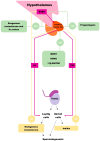Male Hormonal Contraception-Current Stage of Knowledge
- PMID: 40217642
- PMCID: PMC11989589
- DOI: 10.3390/jcm14072188
Male Hormonal Contraception-Current Stage of Knowledge
Abstract
Male hormonal contraception has been the focus of extensive research efforts aimed at identifying effective and reversible methods for male fertility control. This review summarizes the current state of knowledge, key achievements, and future directions in the development of male hormonal contraception. A review was conducted using the PubMed, Embase, and Scopus databases. The search strategy included terms such as "male hormonal contraception", "Nestorone", "7α,11β-Dimethyl-19-nortestosterone 17β-undecanoate (DMAU)" and "11β-methyl-19-nortestosterone 17β-dodecylcarbonate (11β-MNTDC)". A total of 107 references were analyzed to synthesize the most relevant findings regarding the hormonal contraceptive agents under investigation. The review outlines historical and recent advancements in male hormonal contraception, highlighting compounds that have demonstrated limitations in effectiveness, side effects, or inconvenient administration. Notable candidates under study include 7α-methyl-19-nortestosterone (MENT), DMAU, 11β-MNTDC, and the combination of segesterone acetate with testosterone in gel form. These agents show promise due to their ability to suppress follicle-stimulating hormone (FSH) and luteinizing hormone (LH), leading to effective spermatogenesis inhibition with minimal side effects. Additionally, the phenomenon of spermatogenic rebound is considered. Among the investigated agents, oral DMAU, 11β-MNTDC, and the Nestorone-testosterone gel appear to be the most promising candidates for male hormonal contraception due to their high efficacy, user-friendly administration, and favorable safety profiles. However, further large-scale clinical trials are necessary to confirm their long-term effects on human health and fertility, ensuring their viability as future contraceptive options.
Keywords: 11β-MNTDC; DMAU; MENT; Nestorone; contraception; male contraception; male hormonal contraception; spermatogenesis; spermatogenic rebound.
Conflict of interest statement
The authors declare no conflicts of interest.
Figures

References
-
- Haakenstad A., Angelino O., Irvine C.M.S., Bhutta Z.A., Bienhoff K., Bintz C., Causey K., Ashworth Dirac M., Fullman N., Gakidou E., et al. Measuring contraceptive method mix, prevalence, and demand satisfied by age and marital status in 204 countries and territories, 1970–2019: A systematic analysis for the Global Burden of Disease Study 2019. Lancet. 2022;400:295–327. doi: 10.1016/S0140-6736(22)00936-9. - DOI - PMC - PubMed
Publication types
LinkOut - more resources
Full Text Sources

